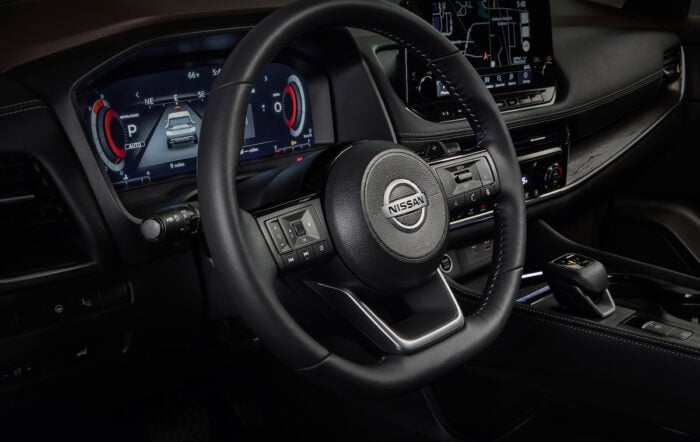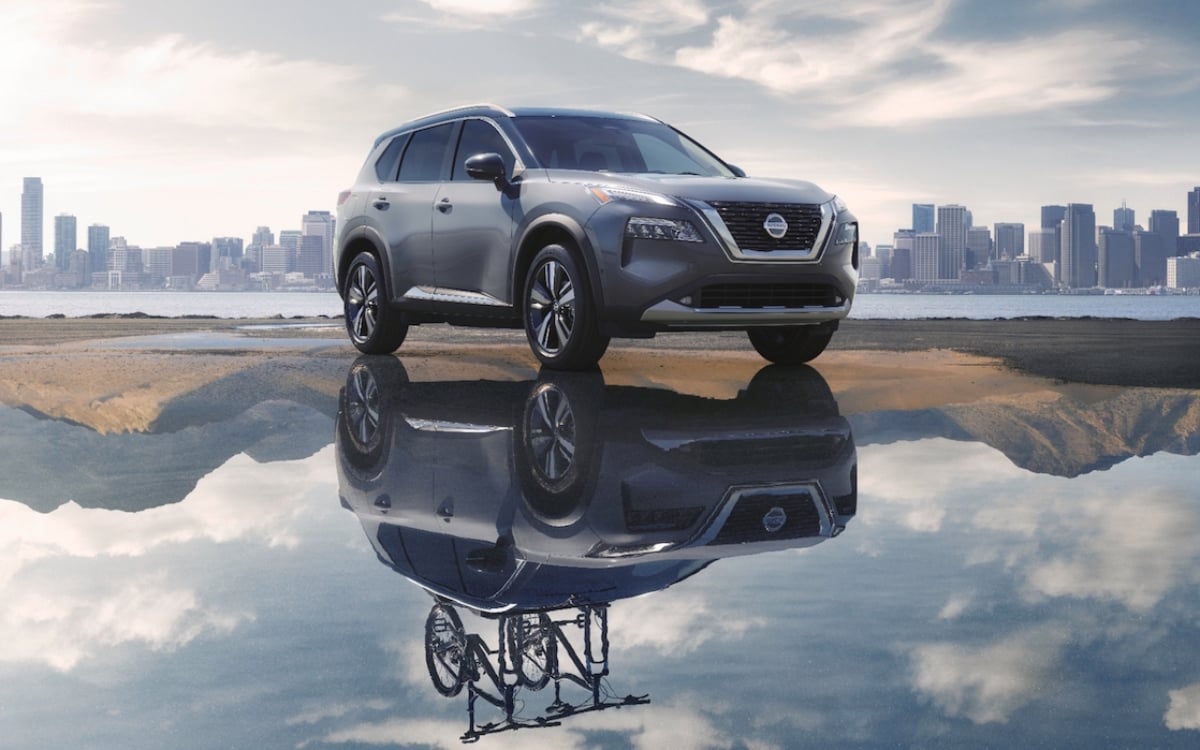The Rogue five-seat crossover SUV is a heartland model for Nissan in the US and Canada, competing against the Ford Escape, Honda CR-V, Toyota RAV4 in a hard-fought compact SUV segment. The Tennessee-built vehicle is the brand’s biggest seller in North America so this all-new, third-generation model, which debuted late last year as a 2021 release, is big news.
2021 Nissan Rogue pricing across North America
US prices range from US$25,850 for the S FWD through to US$37,030 for the Platinum AWD. In Canada there are three grades of Rogue, all available in either FWD or AWD, from the entry-level S FWD (C$28,798 MSRP) via the SV to the Platinum AWD (C$40,798). All Rogues currently share the same 2.5-litre engine.
Our test car was an SV AWD priced at C$34,598. It was fitted with the Premium Package (C$2,200/US$2,660), which adds leatherette seats, heated rear seats, rear-door sunshades and a power liftgate, as well as Boulder Grey pearl paint for an extra C$300, bringing the total MSRP to C$37,098.
Exterior styling
Perhaps unusually for a new model, the Rogue is 38mm (1.5in) shorter and a touch lower than its predecessor. There are familiar styling cues from the outgoing Rogue in details like the gently sloping roofline and kicked-up C-pillar, but the front end is noticeably more squared-off than before and the overall impression is more striking. We liked it, especially in the optional Boulder Grey pearl paint, which unfortunately is not available in the US.
The grey contrasted well with the darker, UV-cutting glasshouse and some striking detailing around the lamp clusters. LEDs are standard in the front and rear headlamps as well as for the daylight running lights. Meanwhile SVs come with 18in alloy wheels, which appropriately for this mid-range machine are one inch larger than the S’s rims and an inch smaller than those on the Platinum.
Interior and equipment

Our SV’s cabin felt disappointingly grey, despite the brown layer around the top of the dashboard and doors, which does not stand out in real life as much as it does in Nissan’s website pictures. In short, it could have used a splash more colour, but it still looked smart. Build quality was good on our test vehicle and the leatherette seats comfortable, although some drivers may find the front seat backs a little narrow. The head- and legroom for rear-seat passengers is adequate and there’s more space in the trunk than in most rivals.
Rogues have had five seats since the previous-generation car lost its seven-seat option after the 2017 model year. The forthcoming X-Trail, the Rogue’s counterpart model in European and Asian markets, has been confirmed with a folding third-row option but so far there’s no indication that seven seats will be making a comeback in the latest Rogue.
We liked that the heating and ventilation switches remain as conventional buttons, rather than being amalgamated into the 9.0in touchscreen. That screen is larger than before and is now placed at the top of the instrument panel, where it is more readily in the driver’s line of sight. The infotainment system includes support for Apple CarPlay, Android Auto and Google Maps with voice recognition.
All Rogues come with Nissan Safety Shield 360, which incorporates all the driver assistance systems we’ve come to expect. SV additionally gets ProPilot Assist, which keeps you centered in the lane and maintains a set distance from the vehicle ahead.
Powertrain: engine and transmission
The Rogue’s 2.5-litre, direct-injection four-cylinder is a relatively new engine that was first seen in the 2019 Altima. With 181HP and 181 lb-ft it brings small power and torque increases over the old Rogue’s motor and is smooth in operation, delivering torque when you need it via a CVT transmission that is less prone to whining than some.

A new electronic shifter liberates handy storage space under a ‘floating’ centre console. Sport mode puts artificial steps in the CVT via steering-wheel paddles, as well as introducing sharper throttle and heavier steering, neither of which felt necessary.
Fuel consumption-wise, we got 8.1L/100km (29mpg) in a week of mixed driving, which is a little better than the official combined economy figure. That’s competitive with other conventionally powered vehicles in the class but given that hybrids are starting to penetrate the segment, we’d expect to see another powertrain option in the Rogue before the end of the model’s life.
AWD features in 75% of Rogues sold in Canada and buyers both here and in areas of the US that are prone to extreme winter weather will appreciate the AWD’s Snow mode.
Driving impressions
Updates to the Renault-Nissan-Mitsubishi Alliance’s CMF-C platform, on which the Rogue is based, have translated to better on-road performance. A new electric steering setup is surprisingly sharp but with better feel than before to give the driver more confidence. Suspension improvements lead to better ride comfort over broken road surfaces and good resistance to roll, pitch and heave.
Unfortunately, there is considerable tire-road noise from the Hankook all-seasons, which detracts from an otherwise quiet cruise. We’re not sure whether this would be better with different-sized rims or different tires, but it might be worth trying a couple of options before you buy.
Takeaway
We said upfront that the Rogue competes in a class packed with capable rivals, but this new model takes a big step forward to rival the best compact crossover SUVs around. The only area where we think it could fall short for some customers is in the lack of a hybrid option to go head-to-head with the RAV4 Hybrid, which is doing great business for Toyota.
An ‘ePower’ hybrid is on the way in 2022 Nissan X-Trails but has yet to be confirmed for the Rogue. We hope to see something similar in North America before too long. Here are some more 2021 and 2021 SUVs worth looking into.
Pros
- sharper styling
- better to drive than previous model
- reasonable economy for a non-hybrid
Cons
- still five seats only
- excessive tire/road noise
- no hybrid option yet
Note: all photos shown are the Platinum AWD trim, not the SV AWD reviewed here.



